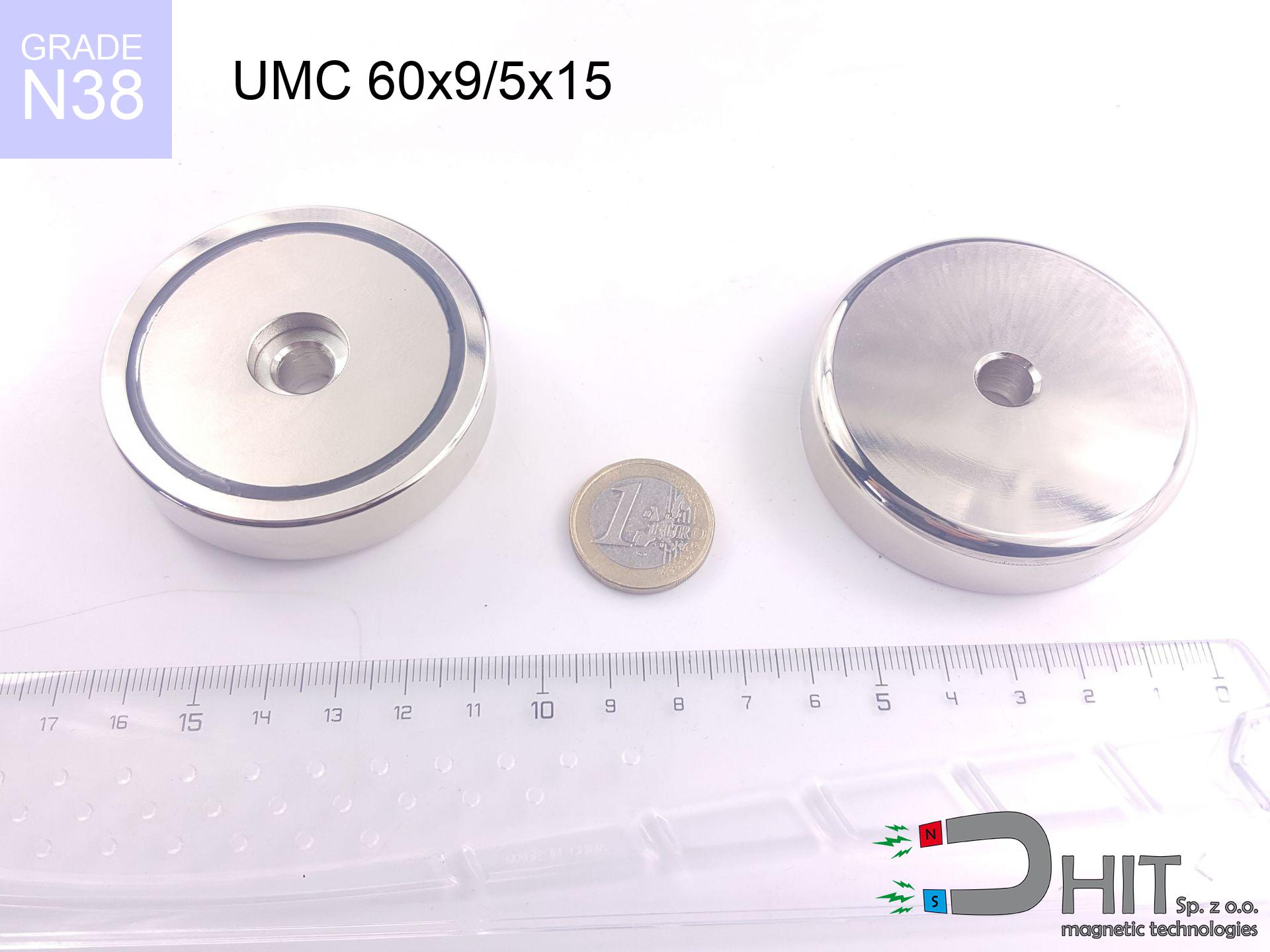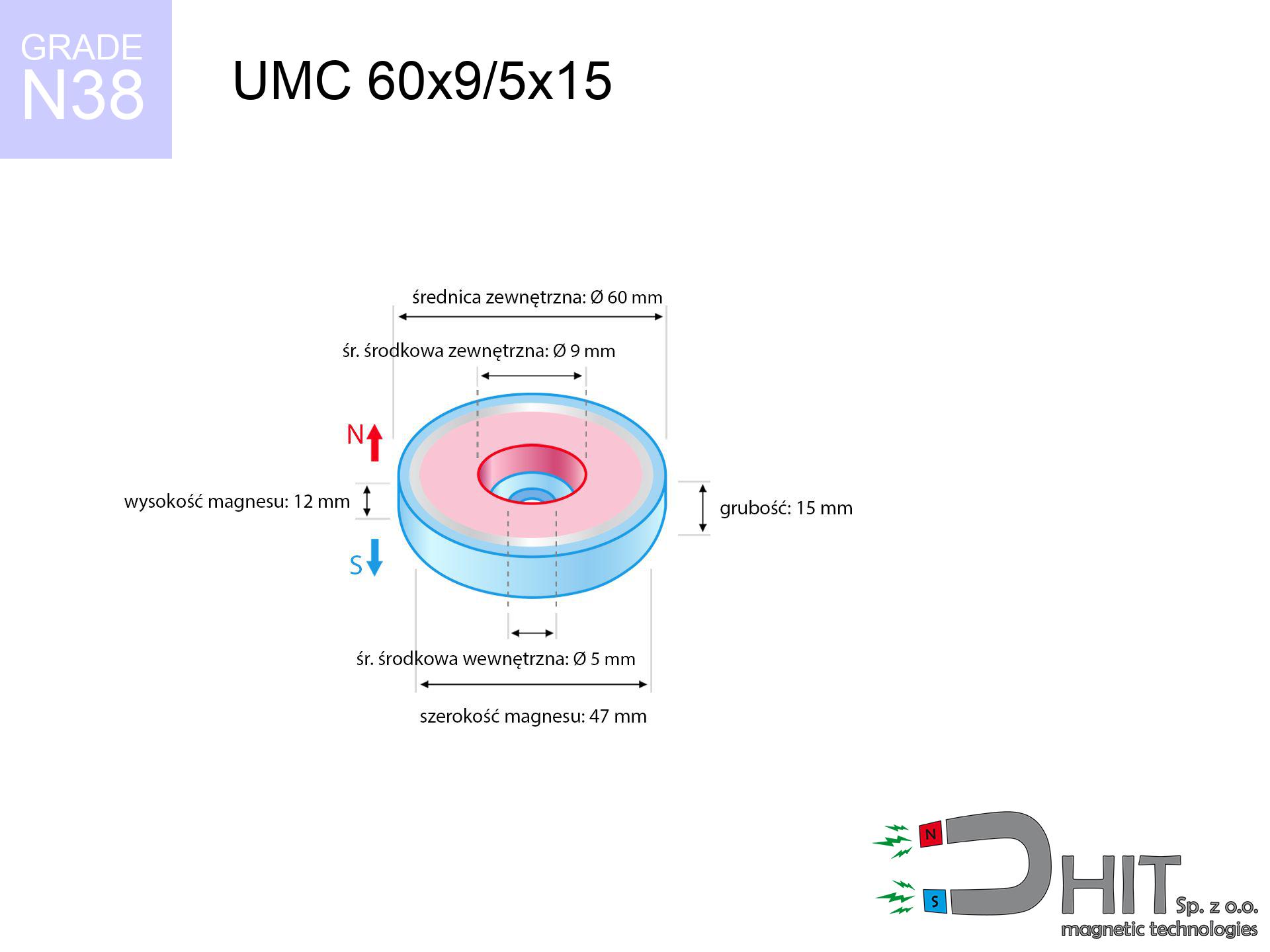UMC 60x9/5x15 / N38
cylindrical magnetic holder
catalog number 320413
GTIN: 5906301814696
external diameter Ø
60
mm [±0,1 mm]
internal diameter Ø
9/5
mm [±0,1 mm]
height
15
mm [±0,1 mm]
capacity ~
95.00 kg / 931.63 N
max. temperature
≤ 80
°C
catalog number 320413
GTIN: 5906301814696
external diameter Ø
60 mm [±0,1 mm]
internal diameter Ø
9/5 mm [±0,1 mm]
height
15 mm [±0,1 mm]
capacity ~
95.00 kg / 931.63 N
max. temperature
≤ 80 °C
64.94 ZŁ gross price (including VAT) / pcs +
52.80 ZŁ net price + 23% VAT / pcs
bulk discounts:
need more quantity?Don't know what to buy?
Give us a call tel: +48 22 499 98 98 or contact us via form on our website. You can check the strength and the appearance of neodymium magnets in our force calculator magnetic mass calculator
Orders placed by 2:00 PM will be shipped on the same business day.
Specification: cylindrical magnetic holder 60x9/5x15 / N38
Magnetic properties of the material N38
Physical properties of sintered neodymium magnets Nd2Fe14B
Shopping tips
Advantages and disadvantages of neodymium magnets NdFeB.
In addition to immense strength, neodymium magnets have the following advantages:
- They do not lose power over time. After 10 years, their strength decreases by only ~1% (theoretically),
- They are highly resistant to demagnetization by external magnetic sources,
- In other words, thanks to the shiny coating of nickel, gold, or silver, the element acquires an aesthetic appearance,
- They exhibit very high magnetic induction on the surface of the magnet,
- By using an appropriate combination of materials, they can achieve significant thermal resistance, allowing them to operate at temperatures up to 230°C and above...
- Thanks to the flexibility in shaping or the ability to adapt to specific requirements – neodymium magnets can be produced in many variants of shapes or sizes, which enhances their versatility in applications.
- Wide application in advanced technologically fields – are utilized in HDD drives, electric drive mechanisms, medical equipment and very highly developed apparatuses.
Disadvantages of neodymium magnets:
- They can break as they are fragile when subjected to a strong impact. If the magnets are exposed to impacts, it is suggested using magnets in a steel housing. The steel housing in the form of a holder protects the magnet from impacts and also increases its overall strength,
- They lose power at high temperatures. Most neodymium magnets experience permanent loss of strength when heated above 80°C (depending on the shape and height). However, we also offer special magnets with high temperature resistance, up to 230°C,
- They rust in a humid environment. For outdoor use, we recommend using waterproof magnets, such as those made of rubber or plastic,
- Limited ability to create threads or complex shapes in the magnet - the use of a housing is recommended - magnetic holder
- Potential hazard associated with microscopic parts of magnets pose a threat, in case of ingestion, which becomes significant in the context of children's health. It's also worth noting that miniscule components of these devices have the potential to complicate diagnosis in case of swallowing.
Precautions
Do not bring neodymium magnets close to GPS and smartphones.
Magnetic fields can interfere with compasses and magnetometers used in aviation and maritime navigation, as well as internal compasses of smartphones and GPS devices. There are neodymium magnets in every smartphone, for example, in the microphone and speakers.
Neodymium magnets can demagnetize at high temperatures.
Even though magnets have been observed to maintain their efficacy up to temperatures of 80°C or 175°F, it's essential to consider that this threshold may fluctuate depending on the magnet's type, configuration, and intended usage.
Neodymium magnets should not be in the vicinity youngest children.
Remember that neodymium magnets are not toys. Be cautious and make sure no child plays with them. They can be a significant choking hazard. If multiple magnets are swallowed, they can attract to each other through the intestinal walls, causing severe injuries, and even death.
Under no circumstances should neodymium magnets be placed near a computer HDD, TV, and wallet.
Neodymium magnets produce strong magnetic fields that can destroy magnetic media such as floppy disks, video tapes, HDDs, credit cards, magnetic ID cards, cassette tapes, or other devices. They can also destroy devices like video players, televisions, CRT computer monitors. Do not forget to keep neodymium magnets at a safe distance from these electronic devices.
Dust and powder from neodymium magnets are flammable.
Do not attempt to drill into neodymium magnets. Mechanical processing is also not recommended. Once crushed into fine powder or dust, this material becomes highly flammable.
Neodymium magnets are over 10 times more powerful than ferrite magnets (the ones in speakers), and their power can shock you.
To use magnets properly, it is best to familiarize yourself with our information beforehand. This will help you avoid significant harm to your body and the magnets themselves.
Neodymium Magnets can attract to each other due to their immense internal force, causing the skin and other body parts to get pinched and resulting in significant swellings.
In the situation of holding a finger in the path of a neodymium magnet, in that situation, a cut or even a fracture may occur.
Neodymium magnets are not recommended for people with pacemakers.
Neodymium magnets generate very strong magnetic fields that can interfere with the operation of a pacemaker. This happens because such devices have a function to deactivate them in a magnetic field.
The magnet coating is made of nickel, so be cautious if you have an allergy.
Studies show a small percentage of people have allergies to certain metals, including nickel. An allergic reaction often manifests as skin redness and rash. If you have a nickel allergy, you can try wearing gloves or simply avoid direct contact with nickel-plated neodymium magnets.
Neodymium magnets are highly susceptible to damage, resulting in breaking.
Neodymium magnets are characterized by significant fragility. Neodymium magnetic are made of metal and coated with a shiny nickel, but they are not as durable as steel. In the event of a collision between two magnets, there may be a scattering of fragments in different directions. Protecting your eyes is crucial in such a situation.
To raise awareness of why neodymium magnets are so dangerous, see the article titled How dangerous are powerful neodymium magnets?.




![magnetic holder with hook 16x5x32 [M4] / N38 ↑ axial magnetic holder with hook 16x5x32 [M4] / N38 ↑ axial](https://cdn3.dhit.pl/graphics/products/umh-16x5x32-m4-lak.jpg)

![magnetic separator 32x475 [2xM8] / N42 magnetic separator 32x475 [2xM8] / N42](https://cdn3.dhit.pl/graphics/products/sm-32x475-2xm8-jot.jpg)

